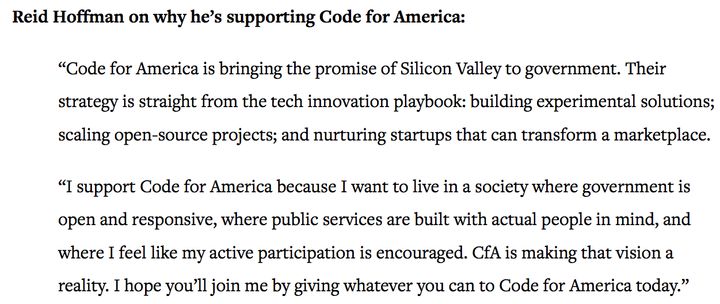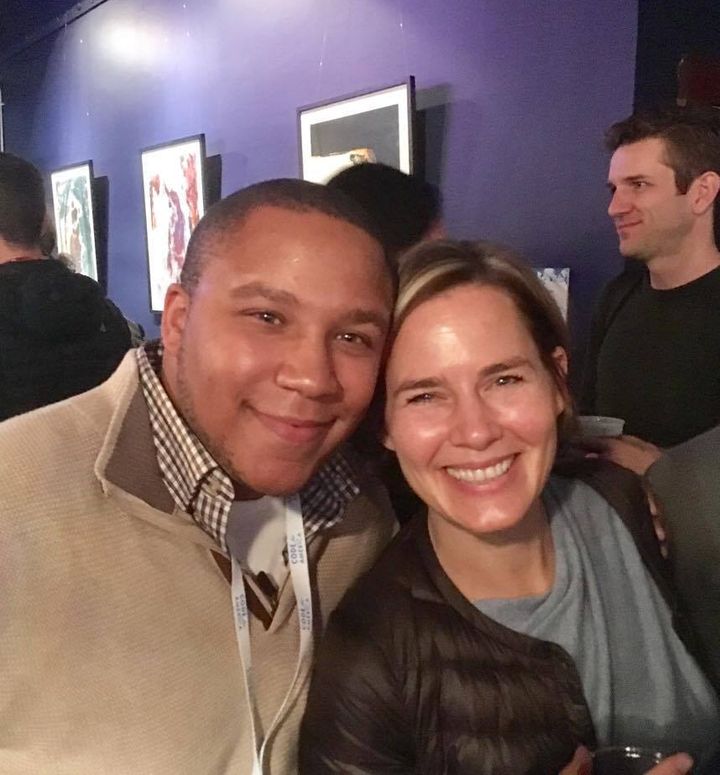
Recently, I interviewed Jennifer Pahlka, the founder and executive director of Code for America. She recently served as the U.S. Deputy Chief Technology Officer in the White House Office of Science and Technology Policy, where she architected and helped found the United States Digital Service. She is known for her TED talk, Coding a Better Government, and is the recipient of several awards, including MIT’s Kevin Lynch Award, the Oxford Internet Institute’s Internet and Society Award, and the National Democratic Institute’s Democracy Award. She spent eight years at CMP Media, where she ran the Game Developers Conference, Game Developer magazine, Gamasutra.com, and the Independent Games Festival. Previously, she ran the Web 2.0 and Gov 2.0 events for TechWeb, in conjunction with O’Reilly Media. She is a graduate of Yale University and lives in Oakland, California with her daughter, husband, and seven chickens. In addition, she recently wrote a great blog post: Procurement Under Trump. Here’s our interview broken into three parts: (1) Code For America’s Evolution, (2) Modular and Agile Procurements, and (3) Global Government Digital Learnings.
Part 1: Code for America’s Evolution
Marquis Cabrera: For folks who don’t know what Code For America (CFA) is, can you give a brief background? Where did the idea for Code for America come from? What pain point is it solving?
Jennifer Pahlka: What we do today is different from when we started, which was with a regulatory perspective. Our government created conditions and regulations that made it hard for tech people in government and government leaders to be really helpful to the people and users that it benefits. We saw that in all levels of government. It was hard to get things done and pushed through pretty quickly, and even simple things became very hard in contract. It’s not that government is bad, but it’s just created a lot of processes to go through before something can actually come to fruition. So we created a Teach for America type organization for developers and designers working in cities to solve a wide variety of problems that those cities have.
Over time, we have found that some of those solutions – such as developers doing service combined with government – are things that should not stop. They should evolve and grow from MVP to be able to benefit every jurisdiction in the country. We’ll continue to build new solutions, but also scale the ones that have enormous impact and effective user solutions. For example, in California, we have helped to launch GetCalFresh, which helps government understand and remove barriers for people accessing food stamps by specifically scaling elements that help the user and government. Now, we are going to take this program national and it will be called “Get Snap.” The model is to focus and then spread: GetCalFresh, to GetSnap.

Currently, we have three areas focusing on spreading work. The first is health. Next is criminal justice, specifically to help users avoid jail and unnecessary incarceration. Lastly is workforce development, in order to enable users to access job training programs. These are a set of services that help the most vulnerable people in our society. Government can work, but let’s start with services for people who have less access. As we grow these focus areas to systematically help users, we will expand into other services, as well.
Marquis Cabrera: What are the major business activities? fellowships, brigades?
Jennifer Pahlka: The work we’re doing today is also being done for the long-term, on a scale that we’ve never dreamed of before, and with very specific outcomes as our goal — outcomes that have a dramatic impact on the lives of people who are most vulnerable in our society. The three outcomes we’re pursuing are food security, reduced incarceration, and employment. GetCalFresh and Clear My Record are products our staff builds with our government partners. The fellowships are heavy in R&D, focused on getting people back to work and reducing unnecessary incarceration. The brigade network with more than 75 chapters is focused on putting technology to work for the benefit of local communities.
Marquis Cabrera: How many fellows have you had? And, how many governments have you worked with?
Jennifer Pahlka: We’ve had hundreds of fellows – 20 a year for 6 years – and worked with thousands of government officials.
Marquis Cabrera: Do you have any favorite fellow projects? I personally loved the caseworker fellowship app in NYC!
Jennifer Pahlka: Officially, I cannot have favorites, but I do have many, many favorites! They all have been wonderful! The first ones started to tell our story, advanced it, and then eventually told a new aspect of it. The most meaningful and exciting thing about each program is that they have taught us how to approach problems in a way that is grounded in respect. Among the people in neighborhoods, public servants, and staff, there can be tense relationships, but we learned how to participate in conversations in a respectful way. There are dozens and dozens of ways to create trust; it is simply just a process of learning by doing.
Marquis Cabrera: What is the future of Code for America? Do you have any new initiatives on the roadmap?
Jennifer Pahlka: The truth is that we would like to do everything, but we can’t. We would love to do more in general! Our mission encourages us to do work. Some potential areas we could grow into are earned income tax credit, unemployment, and food stamps. We will expand to do work wherever we can get good outcomes and have good partners.

LinkedIn Founder Reid Hoffman comments in a CfA press release
Part 2: Modular and Agile Procurements
Marquis Cabrera: What did your sabbatical / time spent working at the White House help you learn that applies to your work with Code for America? For example, the White House Presidential Innovation Fellows were engaged in the RFP-EZ. Were there any lessons that stemmed from there?
Jennifer Pahlka: There was a substantial advantage being at the White House just one floor up from the federal procurement process department. It was great to get to know Matt Blum and understand how much flexibility there is with FAR. Most people see it as extremely constraining, but there are actually provisions that provide an enormous amount of freedom. When you know the law really well, you can use it to generate the outcomes you want that are still consistent with the law. If it’s not specifically called out as illegal and it’s in the best benefit of people, it’s okay. Most of the ossification comes from the practices, not the letter of the law. Conventional wisdom is confused with what the law actually says. If you have air cover, you can be more flexible.
Without the White House asking him to, Mark Schwartz had already been taking large monolithic contracts and turning them into agile modular contracts, which really proved to me that it’s not about some change agent coming from outside, including [Presidential Innovation Fellows]. There are people on the inside – the change is found within the system.
Marquis Cabrera: That being said, I saw you were involved with California’s new child welfare agile procurement process, along with 18F. It was awesome to hear Secretary Marybel Batjer talk about their new agile procurement process and her reaching out to you for your advice. What was the magical recipe you used to convince her and her team to forgo their big bang procurement process – which they were working on for almost a decade – in favor of a modular, agile contracting methodology?
Jennifer Pahlka: Again, I would say that we played a catalytic role. There was a system that didn’t work as well as it should have, but the seeds of change were already there. There’s always risk in something new, but stagnation can get to the point that the status quo may be even riskier. We started to talk to them with the math showing that the old way was deeply problematic, and then showed them that there was a successful alternative proven elsewhere. This is how to get through to people in the private sector: finding a model that works in another context very much like yours. At that point, if the federal government was able to rescue Healthcare.gov with these practices at start of new contracts, then California could do it, as well. It was the concreteness of the examples we presented them and the relevance to their own situation that convinced them. We talked about how U.S. Digital Services worked and a number of the projects they had been able to do post Healthcare.gov, instead of coming in when the system had great risk and agility. Folks at the White House had brought these practices in much earlier in the process. For example, look at College Scorecard, which was built using agile practices. Look at the work that Mark Schwartz is doing at the Office of Immigration. And, finally, Marina Martin has done at the Veterans Administration.
Marquis Cabrera: What are your thoughts on 18F and their approach?
Jennifer Pahlka: In my opinion, I think the effect of 18F can and should be fundamentally positive. Let me tell you a story. There is an unnamed government official in a state that changed how it had done procurements. Afterwards, a particular vendor, who had lost a bid under this new model of procurement, asked the government official for a meeting. The government official thought the vendor was going to be upset with changes. The vendor said to them: “we didn’t qualify because we’re not good enough yet, and we’re going to change. I am doing this because it’s right for the vendor and the American people.” The meeting wasn’t to dispute the agile contracting process, but rather interacting in a way that has better outcomes and is more meaningful. Instead of fight, protect the status quo, become the vendor you should be to help the American people. Vendors who have vision will see this as an opportunity, not as a threat.
Marquis Cabrera: What can vendors do to navigate this new agile procurements marketplace?
Jennifer Pahlka: Vendors have the same problem as governments do. In order to change culture, you have to find change agents and empower them. Some vendors have been really good at doing the same thing for the past 25 years, and then facing change can be daunting. In this situation, it’s important to find the people who have been secretly going along with the status quo, but actually do want to see some change, possibly those who have been going to hackathons. The seeds of change are already there; they just need to be activated. Host a lunch discussing agile procurement or host a hackathon, and then see who shows up and looks concerned. It is possible to change an ecosystem, but doing so will need leadership from the top and build from the bottom. The seeds of change will sow at the bottom. In addition, upskilling people. Giving them exposure with skills that are relevant in the marketplace.
Marquis Cabrera: At the most recent Code for America Summit, I love, love, LOVED that you were able to convene government sector, private sector, entrepreneurs, and techies in one place. For future civic or public entrepreneurs (as Harvard Business School’s Mitch Weiss coins them), what advice would you give to build government partnerships and better ecosystems?
Jennifer Pahlka: I would say it’s important to build a very diverse coalition, inside and out, with a wide variety. Also prioritize building a network with other people in similar positions as you. Everybody in this space is using tactics that their peers have used and the spread of that is important.
They should also find secret unlocked change agents who have yet to be given a platform to stand on. This also works in government. You can identify these people by inviting a diverse audience to brown bag lunch talks, hackathons, or workshops. From these, you can then identify your posse.
Give people some inspiration and themes – or even things – to form connections over. In the UK, they had stickers; the cabinet minister had it on his phone and laptop. Everyone can understand that you need to figure out how to meet user needs. Developers and politicians said their pieces, but Lord Francis Maude said in front of parliament that they are good at meeting government needs, but that they need to do a better job of meeting user needs. Those rally cries allow you to put people who you haven’t identified into procurement, just by using that language and giving them the chance to raise their hands and say, “I am in.”
Part 3: Global Government Digital Learnings
Marquis Cabrera: Since you brought up the UK’s Government Digital Service (GDS)? Can you tell me what we in the US learned from them?
Jennifer Pahlka: The identification of meet user needs was a key one. That framing had not been done in the U.S. and we learned a ton from Mike Bracken in the UK. This is not just about technology, but also about how we government in the frontier that is not yet conquered. It’s not just about better policy implementation, but also about how we can get better regulations from adopting user-centered data driven practices in policy. [GDS Co-Founder] Tom Loosemore talked about it. We started doing it here in the US.
Cecila Munoz talks about the White House Domestic Policy Council, and as a bully pulpit in federal state and local here in the US, she gave a bunch of examples. CFA and DPC talked about policy making in the digital age. The first example was the one at the Code for America Summit. For example, Mina Hsiang on ACA / pubic quality. Regulators made a first pass at the law that would describe the quality coefficient of payment, which is hard to get right. Mina’s digital team did digital product design, and then the regulators could see that people didn’t interact with it the same way they did. As a result, they observed behavior, edited the regulation, and eventually, it became much stronger because of the interaction. This is the thing we need to push much more over the next decade.
Marquis Cabrera: What can GDS and other like International digital government agencies learn from us?
Jennifer Pahlka: The UK learned from us somewhat generally, and we went slower in a more inclusive and consensus-based way. There’s been a slightly head-on collision with the status quo. You can be frustrated with spoils of progress. Giving people more time to adapt can mean greater sustainability with the progress. The sustainability of the progress of movement is in question at the federal level, but it did first start at the local level, even before efforts from the White House. If there are questions on how it will continue, it doesn’t matter because we have a robust community of people who can do at both the state and local level. We can then log this back up to DC if there’s someone more open to it, but we honestly don’t know if Trump people are up for it. The UK was focused on the federal level and on making change.
Marquis Cabrera: Anything else you’d like to share with me?
Jennifer Pahlka: Brigades are the heart and soul of this movement. The movement is about government, which is charged with the task of representing all of us.

Jennifer and I at the most recent Code for America Summit.
